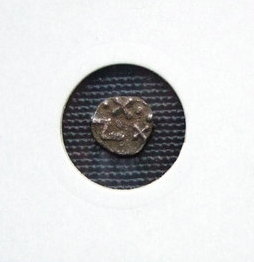
Saxon, Viking & Norman Coins Gallery

Saxon, Viking & Norman Coins Gallery
The popular, and past, notion has been that Martham has Saxon roots. This has now been dispelled but the village certainly had a relatively large population during this period that can be broken down as: Saxon 41o to c1013, Viking c1013 to 1066 and Norman from 1066 to 1154. Despite this long period of occupation coin finds from the period are few and far between. The coins shown in this gallery were found in Martham over the past 50 years by a small number of dedicated metal detector enthusiasts who have spent many hundreds of hours field walking.

Saxon Sceat. Series D, type 2c of the Frisian Primary Series. 675-710. Struck under Radbod or Redbad, King of Frisia. Frisia was a cross-border cultural region in north western Europe encompassing the north of the Netherlands and parts of north western Germany. People from this area were known to have settled at Martham and across the Isle of Flegg to take advantage of the good soil for farming.
Contributor A.



Middle Saxon sceat, series E. Intermediate plumed bird type. 680-710.
Contributor A.

Anglo Saxon silver sceat c695-740. Along the North Sea coasts these tiny silver coins were by far the most convenient and reliable means of payment, from Northern France to Denmark.
Contributor A.


Anglo-Saxon Silver sceat, series 1.
Obverse, left: Bust right with diadem, runic legend EPA in front, annulets around.
Reverse, right. Standard containing TOT II, pellet triangle above, inverse horns.
Contributor A


Coin of Coenwulf of Mercia (796-821) penny. Canterbury mint. Moneyer Tidbearht.
Coenwulf was the King of Mercia for most of the 8th century and was dominant among the Anglo-Saxon kingdoms south of the river Humber.
Contributor A.


Henry I penny (1100-1137). Folded!
Contributor Jean.
